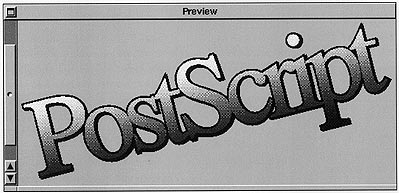|
|
||
| While the evolution of computer technology has
been frenetic, one cannot say its been consistently sensible. The
very expense of most laser printers is a testament to that fact.
On a purely technological level, there is a valid explanation for the high cost of high-quality output: The best laser printers use the PostScript language to generate their images, but the computers that drive them do not. Upon receiving image data from the computer, the PostScript printer is forced to build its image from scratch. It needs its own processor, computing circuitry and laser engine, all of which translates directly into hard currency. It also results in a printed image that can be noticeably different from the one generated on screen. |
||
|
|
||
|
Thankfully, there are no laws requiring this arrangement. The NeXT Computer System presented an opportunity to re-examine what computers have come to, and where they should be going. It's the first computer to offer a unified system for generating both on-screen and printed images: the Display PostScript system. This imaging system brings to the NeXT Computer all the advantages of the PostScript standard. It allows the merging of text and graphics onto a single page. It provides access to literally hundreds of fonts from the Adobe type library, including classical and contemporary, foreign languages, scientific symbols and musical notation. It also makes possible the link between the link NeXT Computer and professional typesetting machines based on the PostScript language, such as those from Linotype, which are capable of achieving 2400 dots per inch resolution. Because NeXT's on-screen image is generated by Display PostScript, you can enjoy many of the benefits of PostScript immediately, instead of having to wait until you seem them in print. Whatever font, type size, degree of rotation or magnification - your work is always displayed clearly. With the screen data already in PostScript form, producing laser output becomes a much simpler process. The NeXT Computer just re-images the screen data to match the printer's resolution and sends it along. Having eliminated the redundant computing hardware, the NeXT Laser Printer is available at a price that actually qualifies it as a personal printer. At the same time, it raises the quality of laser printing to 400 dots per inch, compared to the industry-standard 300. That's an improvement in overall resolution of more than 75% (160,000 dots per square inch vs. 90,000). The NeXT Laser Printer is also capable of 300 dpi quality, only now you can think of it as draft mode. There are other features to make printing more efficient, as well. The paper tray is adjustable to accommodate a variety of paper and envelope sizes. And a straight paper path lowers the risk of paper jams associated with more circuitous routes. The NeXT Computer System is designed to be exactly that - a complete system. Placing a printer of such quality on your desktop means an end to having to walk down the hall to retrieve documents from a shared printer. Or wasting time in line as others print before you. Now laser printing is economically feasible for the individual, and at a higher quality than has ever been possible. This is the future of personal printing. |
|
|
||||
| While laser printers have come and gone, the quality standard has remained at 300 dots per inch. | The NeXT Laser Printer gives you 75% better resolution. | |||
| About the Display PostScript
system.
The screen image system used by the NeXT Computer is Display PostScript - an extension of Adobe's PostScript page description language. For the user, it provides immediate and practical benefits, as described above. For the programmer, it offers still more advantages. The display portion of programs written for Display PostScript will function perfectly on any computer supporting Display PostScript (though NeXT is the first, others will surely follow). So important routines need not be rewritten when ported to other environments. It's also device independent, in that an image defined in Display PostScript as a certain size and shape will print in precisely that size and shape on any PostScript-based printer, no matter who manufactures it. With these advantages, and speed as well, Display PostScript is quickly gaining support as the standard imaging system of the '90s. |

